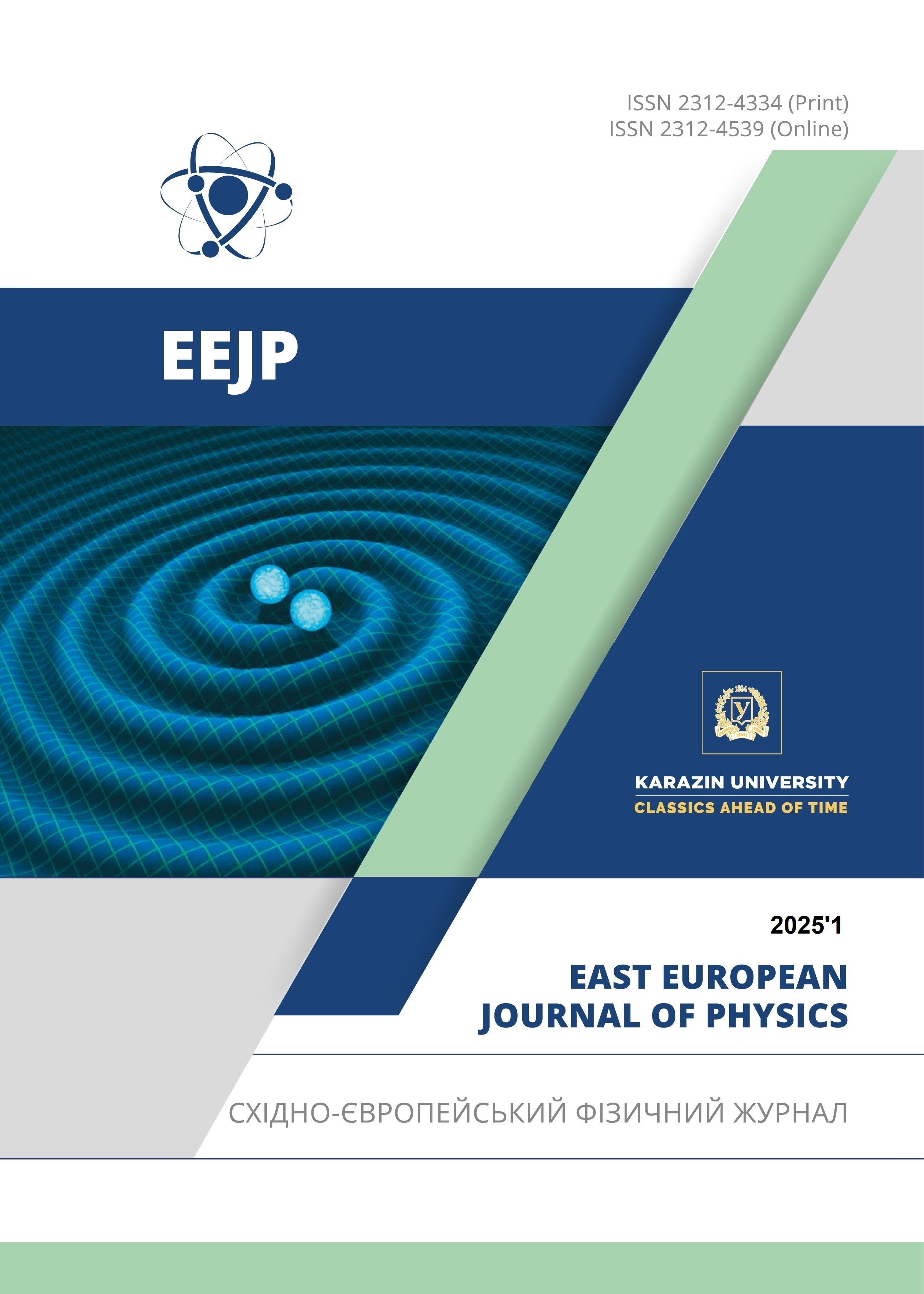Bianchi Type VI0 Generalized Ghost Pilgrims Dark Energy Cosmological Model in Saez-Ballester Theory of Gravitation
Abstract
The Generalized Ghost Pilgrim Dark Energy (GGPDE) in the Saez-Ballester Theory of Gravitation (SBTG) and the Bianchi type VI0 space-time framework serve as the foundation for this work. We used Mishra and Dua's [Astrophys. Space Sci. 366, 6 (2021)] straightforward parameterization of average scale factor a(t) = exp{(αt+β)p} to find precise solutions to the field equations. We have looked into the GGPDE and dark matter (DM), both when they interact and when they don't. For both models, some significant and well-known parameters are produced, including the Hubble parameter, the equation of state (EOS) parameter, the deceleration parameter, etc. It is discovered that for both models, the deceleration parameter denotes an accelerated phase and the EOS parameter a cosmological constant. For both the non-interacting and interacting models, the stability analysis and energy conditions are examined.
Downloads
References
R.K. Mishra, and H. Dua, “Evolution of FLRW universe in Brans-Dicke gravity theory,” Astrophys. Space Sci. 366, 6 (2021). https://doi.org/10.1007/s10509-020-03908-0
A.G. Riess, et al., “Observational Evidence from Supernovae for an Accelerating Universe and a Cosmological Constant,” Astron. J. 116, 1009–1038 (1998). https://doi.org/10.1086/300499
D.N. Spergel, et al., “First Year Wilkinson Microwave Anisotropy Probe (WMAP) Observations: Determination of Cosmological Parameters,” Astrophys. J. Suppl. Ser. 148, 175–194 (2003). https://doi.org/10.1086/377226
M. Tegmark, et al., “Cosmological parameters from SDSS and WMAP,” Phys. Rev. D, 69, 10350 (2004); S. Weinberg, “The cosmological constant problem,” Rev. Mod. Phys. 61, 103501 (1989). https://doi.org/10.1103/PhysRevD.69.103501
S. Weinberg, “The cosmological constant problem,” Rev. Mod. Phys. 61, 1 (1989). https://doi.org/10.1103/RevModPhys.61.1
P. Steinhardt, L. Wang, and I. Zlatev, “Cosmological tracking solutions,” Phys. Rev. D, 59, 123504 (1999). https://doi.org/10.1103/PhysRevD.59.123504
R.R. Caldwell, “A phantom menace? Cosmological consequences of a dark energy component with super-negative equation of state,” Phys. Lett. B, 545, 23-29 (2002). https://doi.org/10.1016/S0370-2693(02)02589-3
S. Noijiri, S.D. Odintsov, and S. Tsujikawa, “Properties of singularities in the (phantom) dark energy universe,” Phys. Rev. D, 71, 063004 (2005). https://doi.org/10.1103/PhysRevD.71.063004
T. Padmanabhan, “Accelerated expansion of the universe driven by tachyonic matter,” Phys. Rev. D, 66, 021301(R) (2002). https://doi.org/10.1103/PhysRevD.66.021301
M. Gasperini, F. Piazza, and G. Veneziano, “Quintessence as a runaway dilaton,” Phys. Rev. D, 65, 023508 (2001). https://doi.org/10.1103/PhysRevD.65.023508
F.R. Urban, and A.R. Zhitnitsky, “The cosmological constant from the QCD Veneziano ghost,” Phys. Lett. B, 688(1), 9–12 (2010). https://doi.org/10.1016/j.physletb.2010.03.080
N. Ohta, “Dark energy and QCD ghost,” Phys. Lett. B, 695, 41-44 (2011). https://doi.org/10.1016/j.physletb.2010.11.044
R.G. Cai, Z.L. Tuo, H.B. Zhang, and Q. Su, “Notes on ghost dark energy,” Phys. Rev. D, 84(12), 123501 (2011). https://doi.org/10.1103/PhysRevD.84.123501
A.R. Zhitnitsky, “Gauge fields and ghosts in Rindler space,” Phys. Rev. D, 82(10), 103520 (2010). https://doi.org/10.1103/PhysRevD.82.103520
B. Holdom, “From confinement to dark energy,” Phys. Lett. B, 697(4), 351–356 (2011). https://doi.org/10.1016/j.physletb.2011.02.024
A.R. Zhitnitsky, “Contact Term, its Holographic Description in QCD and Dark Energy,” arXiv:1112.3365[hep-ph], Phys. Rev. D, 86, 045026 (1988). https://doi.org/10.1103/PhysRevD.86.045026
M. Maggiore, L. Hollenstein, M. Jaccard, and E. Mitsou, “Early dark energy from zero-point quantum fluctuations,” Phys. Lett. B, 704(3), 102-107 (2011). https://doi.org/10.1016/j.physletb.2011.09.010
R.G. Cai, Z.L. Tuo, Y.B. Wu, and Y.Y. Zhao, “More on QCD Ghost Dark Energy,” arXiv:1201.2494v2[astro-ph.CO], Phys. Rev. D, 86, 023511 (2012). https://doi.org/10.1103/PhysRevD.86.023511
H. Wei, “Pilgrim Dark Energy,” arXiv: 1204.4032v3[gr-qc], Class. Quantum Grav. 29, 175008 (2012). https://doi.org/10.1088/0264-9381/29/17/175008
M. Sharif, and A. Jawad, “Analysis of generalized ghost version of pilgrim dark energy,” Astrophys. Space Sci. 351, 321-328 (2014). https://doi.org/10.1007/s10509-014-1833-y
M.V. Santhi, V.U.M. Rao, and Y. Aditya, “Anisotropic Generalized Ghost Pilgrim Dark Energy Model in General Relativity,” Int. J. Theor. Phys. 56, 362-371 (2017). https://doi.org/10.1007/s10773-016-3175-8
A. Jawad, “Analysis of Generalized Ghost Pilgrim Dark Energy in Non-flat FRW Universe,” arXiv: 1412.4000v1[gr-qc], Eur. Phys. J. C, 74, 3215 (2014). https://doi.org/10.1140/epjc/s10052-014-3215-6
P. Garg, A. Dixit, and A. Pradhan, “Cosmological models of generalized ghost pilgrim dark energy (GGPDE) in the gravitation theory of Saez-Ballester,” arXiv: 2004.11153v1[physics. gen-ph], International Journal of Geometric Methods in Modern Physics, 18(14), 2150221 (2020). https://doi.org/10.1142/S0219887821502212
R. Bali, and P. Kumari, “Bianchi Type VI0 inflationary universe with constant declaration parameter and flat potential in General Relativity,” Advances in Astrophysics, 2(2), 67-72 (2017). https://dx.doi.org/10.22606/adap.2017.22001
G.G. Luciano, “Saez–Ballester gravity in Kantowski–Sachs Universe: A new reconstruction paradigm for Barrow Holographic Dark Energy,” Physics of the Dark Universe, 41, 101237 (2023). https://doi.org/10.1016/j.dark.2023.101237
T. Vinutha, and K.V. Vasavi, “The study of accelerating DE models in Saez–Ballester theory of gravitation,” Eur. Phys. J. Plus, 137, 1294 (2022). https://doi.org/10.1140/epjp/s13360-022-03477-x
H. Wei, and R.G. Cai, “Interacting agegraphic dark energy,” Eur. Phys. J. C, 59, 99-105 (2009). https://doi.org/10.1140/epjc/s10052-008-0799-8
K.S. Adhav, “LRS Bianchi Type-I universe with anisotropic dark energy in lyra geometry,” Int. J. Astron. Astrophys. 1(4), 204 209 (2011). http://dx.doi.org/10.4236/ijaa.2011.14026
Y.S. Myung, “Instability of holographic dark energy models. Phys. Lett. B, 652, 223-227 (2007). https://doi.org/10.1016/j.physletb.2007.07.033
Copyright (c) 2025 Tenneti Ramprasad, M.P.V.V. Bhaskara Rao, M. Kiran, Satyanarayana Bora

This work is licensed under a Creative Commons Attribution 4.0 International License.
Authors who publish with this journal agree to the following terms:
- Authors retain copyright and grant the journal right of first publication with the work simultaneously licensed under a Creative Commons Attribution License that allows others to share the work with an acknowledgment of the work's authorship and initial publication in this journal.
- Authors are able to enter into separate, additional contractual arrangements for the non-exclusive distribution of the journal's published version of the work (e.g., post it to an institutional repository or publish it in a book), with an acknowledgment of its initial publication in this journal.
- Authors are permitted and encouraged to post their work online (e.g., in institutional repositories or on their website) prior to and during the submission process, as it can lead to productive exchanges, as well as earlier and greater citation of published work (See The Effect of Open Access).








